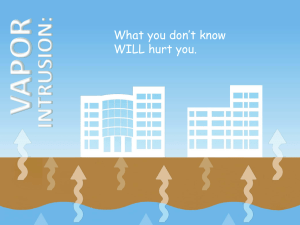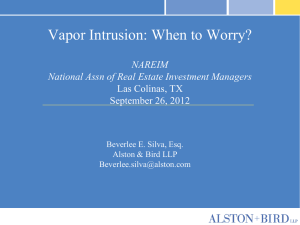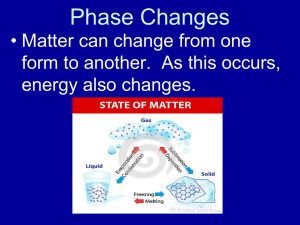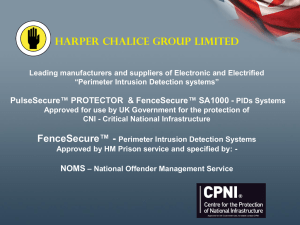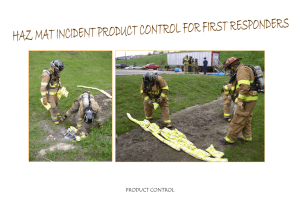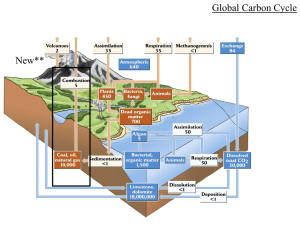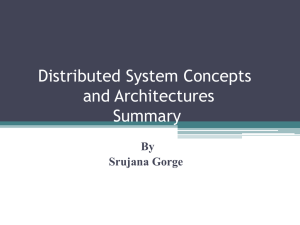Workshop 6: Looking Beyond Natural Variation in Vapor Intrusion
advertisement
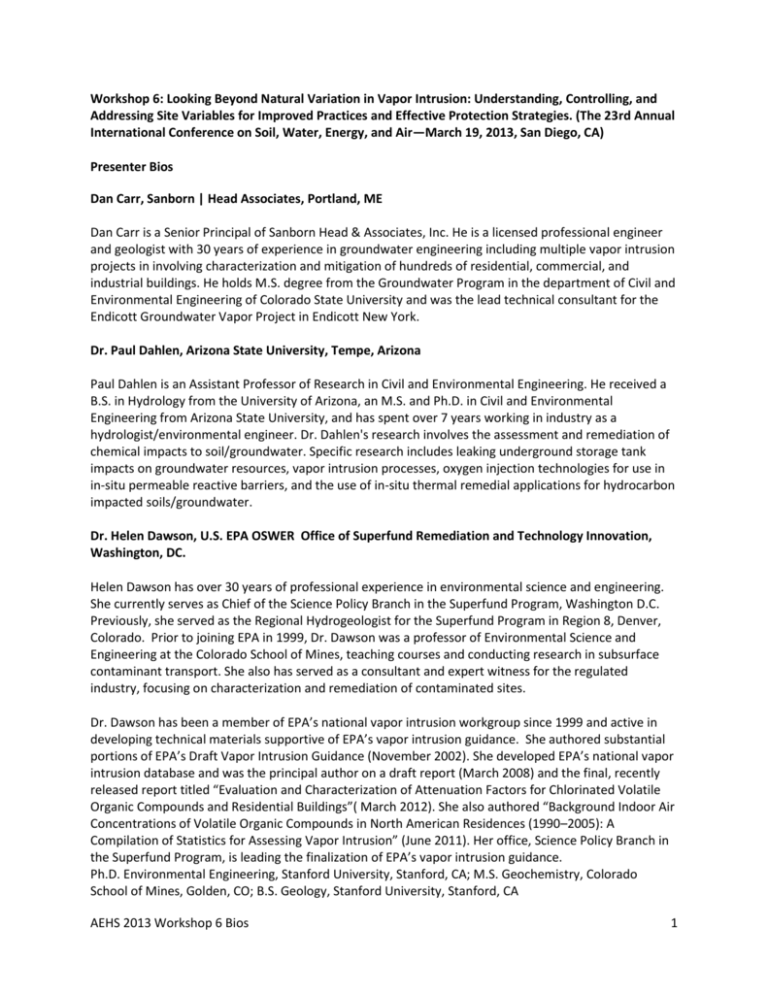
Workshop 6: Looking Beyond Natural Variation in Vapor Intrusion: Understanding, Controlling, and Addressing Site Variables for Improved Practices and Effective Protection Strategies. (The 23rd Annual International Conference on Soil, Water, Energy, and Air—March 19, 2013, San Diego, CA) Presenter Bios Dan Carr, Sanborn | Head Associates, Portland, ME Dan Carr is a Senior Principal of Sanborn Head & Associates, Inc. He is a licensed professional engineer and geologist with 30 years of experience in groundwater engineering including multiple vapor intrusion projects in involving characterization and mitigation of hundreds of residential, commercial, and industrial buildings. He holds M.S. degree from the Groundwater Program in the department of Civil and Environmental Engineering of Colorado State University and was the lead technical consultant for the Endicott Groundwater Vapor Project in Endicott New York. Dr. Paul Dahlen, Arizona State University, Tempe, Arizona Paul Dahlen is an Assistant Professor of Research in Civil and Environmental Engineering. He received a B.S. in Hydrology from the University of Arizona, an M.S. and Ph.D. in Civil and Environmental Engineering from Arizona State University, and has spent over 7 years working in industry as a hydrologist/environmental engineer. Dr. Dahlen's research involves the assessment and remediation of chemical impacts to soil/groundwater. Specific research includes leaking underground storage tank impacts on groundwater resources, vapor intrusion processes, oxygen injection technologies for use in in-situ permeable reactive barriers, and the use of in-situ thermal remedial applications for hydrocarbon impacted soils/groundwater. Dr. Helen Dawson, U.S. EPA OSWER Office of Superfund Remediation and Technology Innovation, Washington, DC. Helen Dawson has over 30 years of professional experience in environmental science and engineering. She currently serves as Chief of the Science Policy Branch in the Superfund Program, Washington D.C. Previously, she served as the Regional Hydrogeologist for the Superfund Program in Region 8, Denver, Colorado. Prior to joining EPA in 1999, Dr. Dawson was a professor of Environmental Science and Engineering at the Colorado School of Mines, teaching courses and conducting research in subsurface contaminant transport. She also has served as a consultant and expert witness for the regulated industry, focusing on characterization and remediation of contaminated sites. Dr. Dawson has been a member of EPA’s national vapor intrusion workgroup since 1999 and active in developing technical materials supportive of EPA’s vapor intrusion guidance. She authored substantial portions of EPA’s Draft Vapor Intrusion Guidance (November 2002). She developed EPA’s national vapor intrusion database and was the principal author on a draft report (March 2008) and the final, recently released report titled “Evaluation and Characterization of Attenuation Factors for Chlorinated Volatile Organic Compounds and Residential Buildings”( March 2012). She also authored “Background Indoor Air Concentrations of Volatile Organic Compounds in North American Residences (1990–2005): A Compilation of Statistics for Assessing Vapor Intrusion” (June 2011). Her office, Science Policy Branch in the Superfund Program, is leading the finalization of EPA’s vapor intrusion guidance. Ph.D. Environmental Engineering, Stanford University, Stanford, CA; M.S. Geochemistry, Colorado School of Mines, Golden, CO; B.S. Geology, Stanford University, Stanford, CA AEHS 2013 Workshop 6 Bios 1 David Folkes, EnviroGroup Limited, Denver, CO Mr. Folkes is a Principal of EnviroGroup, a Geosyntec company, and a civil engineer with over 30 years of experience as an environmental consultant in the U.S. and Canada. He has worked on over 100 vapor intrusion projects across North America and overseas, including management of the Redfield Site in Colorado, and has served as an expert witness for several vapor intrusion lawsuits. Mr. Folkes was a member of the Interstate Technology & Regulatory Council (ITRC) team that developed the vapor intrusion guidance and has served as an instructor for their vapor intrusion class for the past three years. He is currently a member of the Petroleum Vapor Intrusion team. Mr. Folkes has presented a number of papers on vapor intrusion topics over the past 12 years, including transient and temporal variability, background levels in indoor air, and mitigation. His current research focuses on the use of aerated floors for passive and sustainable mitigation. Doug Grosse, U.S. EPA ORD National Risk Management Research Laboratory, Cincinnati, OH Douglas W. Grosse has a B.A. in English Literature from Ohio University and an M.S. in Environmental Engineering from the University of Cincinnati. He has worked as an Environmental Engineer at the U.S. Environmental Protection Agency (EPA) in Cincinnati, Ohio for the past 32 years. Mr. Grosse is currently working in EPA's National Risk Management Research Laboratory (NRMRL) as a Senior Environmental Engineer. Past experiences have included: in-house research at EPA's pilot plant facilities in wastewater and hazardous waste research; pilot facility manger and project officer (Center Hill Laboratory); Superfund Innovative Technology Evaluation (SITE) Program; RCRA corrective action coordinator and technical assistance in Superfund, RCRA and treatability study assistance, as an aqueous treatment specialist, Acting Branch chief, Technology Transfer Branch, and ETV/AMS Center PO. Currently, Mr. Grosse is working in the Remediation and Redevelopment Branch and Engineering Technical Support Center, as a specialist in site remediation and technology transfer. Yuanming Guo, Arizona State University, Tempe, AZ Yuanming Guo has been a Ph.D student in the School of Sustainable Engineering and the Built Environment at Arizona State University since 2011. His research focuses on vapor phase contaminant migration in the subsurface. Chase Holton, Arizona State University, Tempe, AZ Chase Holton obtained his B.S. in Civil Engineering from Washington State University in 2010. He is currently working towards his Ph.D. in Environmental Engineering at Arizona State University. His research involves studying the groundwater to indoor air pathway for chlorinated solvent-impacted groundwater at a residential house near Hill Air Force base in Layton, Utah. Dr. Paul C. Johnson, Arizona State University, Tempe, AZ Paul Johnson is a Professor and the Dean of the Ira A. Fulton Schools of Engineering at Arizona State University (ASU). Prior to joining ASU in 1994, Dr. Johnson was a senior research engineer at the Shell Oil/Shell Chemical Westhollow Technology Center in Houston, Texas. Dr. Johnson’s expertise is in soil and groundwater remediation and risk assessment, specifically, the design, monitoring and optimization of remediation systems and the monitoring and modeling of exposure pathways. He has served as an AEHS 2013 Workshop 6 Bios 2 advisor to regulatory agencies and industry on these topics. From 2003 through 2011, Dr. Johnson served as the editor for the National Ground Water Association’s journal, Ground Water Monitoring and Remediation. His research group was recently awarded the 2011 Strategic Environmental Research and Development Program (SERDP) Project of the Year Award for their ongoing study of vapor intrusion at a home in Utah. Jill Johnston, University of North Carolina in Chapel Hill Jill Johnston is a PhD candidate in Environmental Sciences and Engineering at in School of Public Health at the University of North Carolina in Chapel Hill. Jill’s research focuses in probabilistic modeling and analysis of vapor intrusion at a contaminated site in Texas. She has extensive experience in communitybased participatory research. Jill was awarded a National Science Foundation Graduate Student Research Fellowship. She earned an M.S. in environmental sciences and engineering from UNC in 2010 and holds a B.A. in geology and environmental science from Wesleyan University. Dr. Jeff Kurtz, EnviroGroup Limited, Denver, CO Jeff Kurtz is a Senior Scientist at EnviroGroup/Geosyntec and has over twenty years of experience as a consulting Geologist/Geochemist. Dr. Kurtz is the indoor air testing manager for one of the largest vapor intrusion sites in the country (Redfield), with responsibilities that include evaluating the extent of vapor intrusion impacts and the performance of vapor intrusion controls, and evaluating the contributions of indoor sources and background to indoor air levels of VOCs. He has worked on a number of other vapor intrusion sites in Colorado, California, Kansas, New Jersey, New York, North Carolina, Ohio, Puerto Rico, Utah and Wyoming, and is well known for his research and publications on indoor sources of VOCs, including the use of COC ratios in groundwater and indoor air to separate vapor intrusion from background sources. Dr. Kurtz worked closely with Dr. Paul Johnson and Robbie Ettinger to publish the first study providing validation of the J&E Model from empirical data. Dr. Hong Luo, Chevron Energy Corporation Hong Luo is an Environmental Hydrogeologist at Chevron Energy Corporation. Her Ph.D. dissertation at Arizona State University focused on the measurement and modeling of temporal and spatial variability in indoor air and subsurface vapor concentrations at petroleum hydrocarbon sites. From 2009 – 12 she was an assistant research professor at ASU focused on field monitoring and modeling for chlorinated hydrocarbon sites and was the project lead for the Layton, UT study site. Chris Lutes, ARCADIS, Inc., Durham, NC Christopher Lutes (Chris) is an Associate Vice President and Principal Scientist with ARCADIS. He has over twenty years of experience managing technology evaluations, remediation projects, pollutant fate and transport studies, and air emissions characterizations for ARCADIS. He was a lead author for the EPA engineering issue on Vapor Intrusion Mitigation and has authored more than 100 other publications. He has worked with EPA to conduct several research studies of the uses of radon as a tracer for Vapor Intrusion, temporal variability and passive sampling methods. Mr. Lutes holds a B.S. in Chemistry from the University of Virginia and an M.S. in Environmental Science and Engineering from the University of North Carolina at Chapel Hill. AEHS 2013 Workshop 6 Bios 3 Todd McAlary, P.Eng., P.G., Geosyntec Consulants, Inc., Guelph, ON Todd McAlary is the Vapor Intrusion Practice Leader for Geosyntec Consultants, Inc. He has degrees in Geological Engineering and Hydrogeology from the University of Waterloo, where he measured and modeled vapor diffusion through unsaturated sands as his Master’s Thesis. Mr. McAlary has over 20 years of consulting experience, primarily for Fortune 500 companies in the United States. He has conducted site-specific investigations of vapor intrusion since 1992, co-authored or peer reviewed over a dozen guidance documents on vapor intrusion over the past 12 years, and has presented research in this field at over 40 conferences, workshops, and training sessions. He received the 2006 Industry Recognition Award for his contribution to the ITRC vapor intrusion guidance and has been a member of the Federal EPA Expert Panel on Vapor Intrusion since 2000. Mr. McAlary is currently managing largescale vapor intrusion investigations for the DOD, conducting applied research for ESTCP, the Navy and the Air Force to improve vapor intrusion assessment methods, completing a part-time Ph.D. in Chemistry and teaching part-time at the University of Toronto. Dr. Brian Schumacher, U.S. EPA, ORD, National Exposure Research Laboratory, Las Vegas, NV Brian Schumacher is the Branch Chief of the Environmental Chemistry Branch of the United States Environmental Protection Agency’s Office of Research and Development in Las Vegas, NV. Brian was hired by the U.S. EPA in 1991 to take the lead and address ways to improve the sampling and analysis of soils contaminated with volatile organic compounds. This research has led to his natural progression into the arena of vapor intrusion. Dr. Schumacher is currently conducting research in numerous areas related to vapor intrusion including: the improvement/standardization of soil gas sampling methodologies; the spatial and temporal variability of VOCs in the environment (in both subslab and uncovered areas), and passive vapor intrusion sampling. His recent research efforts have been focused on looking at the long-term (>1 year) temporal and spatial variability of VOC and radon concentrations in and around a home in Indianapolis, Indiana. The latest research effort at the Indianapolis house is designed to examine the influence of an installed mitigation system on the fluctuation of VOC and radon concentrations. Dr. Henry Schuver, U.S. EPA OSWER Office of Resource Conservation and Recovery, Washington, DC Originally trained as geologist (BS, MS), Henry Schuver began his environmental career in the hazardous waste program in New Jersey Department of Environmental Protection (NJDEP; 1986-1989), proceeded to private consulting (1989-1995), returned to a regulatory position as Resource Conservation and Recovery Act (RCRA) case manager in U.S. EPA Region 2 (1995- 1997) and then transferred to U.S. EPA headquarters RCRA Cleanup Program. In headquarters to help meet GPRA requirements he authored the 1999 guidance for multiple pathway RCRA Environmental Indicators (EIs) for Human Health and Groundwater Under Control determinations, which became the model for Superfund program’s EI and are still used as common metric for progress at cleanup sites for the Agency-wide annual Report on the Environment. For the EI guidance he convinced the RCRA program to evaluate indoor air at all of the high priority sites and managed the development of the 2001 RCRA vapor Intrusion (VI) guidance which lead to the OSWER-wide 2002 draft and 2012 draft-final VI guidance efforts. Over the years in headquarters he has lead national conferences on EIs and more recently VI, earned his Dr. of Public Health degree, and is currently focused on evidence-based approaches to maximize the health benefits and cost-effectiveness of VI efforts for all parties involved. AEHS 2013 Workshop 6 Bios 4 Dr. Daniel J. Steck, St. John’s University, Schaefer Environmental Radiation Laboratory Daniel J. Steck is Professor of Physics and the Director of the Schaefer Environmental Radiation Laboratory at St. John’s University. Dr. Steck has been actively researching radon for more than 30 years in the areas of radon detection, potential mapping, spatial and temporal variation, dosimetry for epidemiology, and the cost effectiveness of lung cancer prevention via radon mitigation. Dr. Steck has been a consultant to the World Health Organization, the ICRU, and radiation protection agencies in the United States, Canada, Italy, China, Hungary, and Finland. His work has resulted in more than 70 publications and several awards, including the 2010 Nexus Award from the American Association of Radon Scientists and Technologists. Robert S. Truesdale, RTI International, Research Triangle Park, NC Robert Truesdale is a Senior Research Geologist with RTI International’s Water and Ecosystem Management Center. Mr. Truesdale has worked in support of U.S. EPA research on multimedia environmental pollution issues for over 30 years, with work ranging from sampling and analysis to risk assessment. He has been involved in vapor intrusion research and regulatory development since 2000, including work for the Indiana Department of Environmental Management and EPA’s ORCR, ORD, and OUST. He has managed and organized 9 consecutive vapor intrusion technical workshops and two stakeholder forums for EPA ORCR and ORD. He received a B.A. in Geology from Duke University in 1975 and a M.S. in Geologic Sciences from the University of Maine in 1975. He has worked at RTI since 1978. John H. Zimmerman, U.S. EPA, U.S. EPA ORD, National Exposure Research Laboratory, Las Vegas, NV John H. Zimmerman is a Supervisory Physical Scientist with the EPA. He received a B.A. in Chemistry and an M.S. in Water Resource Management from the University of Nevada, Las Vegas. He has worked on research activities focused on development, evaluation, and verification of methodologies for collection, transportation, and analysis of VOCs in soils, water and air for over 20 years. The current focus of his research has been on VI issues related to sampling and analysis. AEHS 2013 Workshop 6 Bios 5

